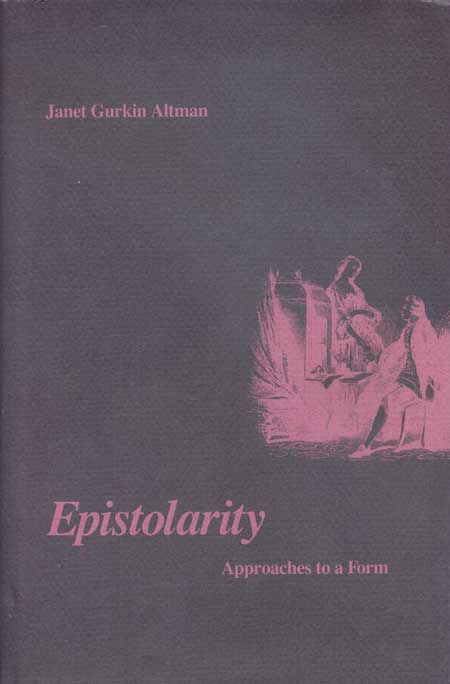| click here to read the complete text of the book | leave / read comments and critiques of the book |

Epistolarity
Approaches to a Form
Janet Gurkin Altman
Though the letter’s potential as an artistic form and a narrative vehicle has been recognized by writers of nearly every nationality and period from Ovid, in the Epistulae Heroidum, to Saul Bellow, in Herzog, epistolary literature has only recently become the object of close and sustained critical scrutiny as a result of the revival of the letter form in contemporary fiction, and a growing recognition that the genre was not, in fact, abandoned following the period of its greatest popularity in the eighteenth century. This was the age that produced such classics as Montesquieu’s Lettres persanes, Richardson’s Pamela and Clarissa, Rousseau’s La Nouvelle Hélo�se, Smollett’s Humphry Clinker, Goethe’s Werther, and Laclos’s Les Liaisons dangereuses.
Such well-known works, Professor Altman suggests, though they represent a wide diversity in style, plot, and characterization, reveal a surprising number of similar literary structures or intriguingly persistent patterns when read together with other examples of the epistolary genre. And these structures—recurring thematic relations, character types, narrative events and organization—can, in turn, be related to properties inherent in the letter itself. For in numerous instances, these basic formal and functional characteristics of the letter, far from being purely ornamental, significantly affect the way in which meaning is constructed, consciously and unconsciously, by both writers and readers.
The epistolary novel, Dr. Altman points out, was born in an age when novelists like Diderot and Sterne had moved beyond story-telling to indulge in playful reflection upon history and fiction, and the means by which historical and fictional events are recounted. She suggests that the epistolary form is experiencing a renaissance at the present time simply because, in this postmodernist era, so much fiction is questioning the representational status of writing, and a discursive self-consciousness is overtly challenging the novel’s traditional narrativity.
In this first book-length treatment of the broad topic of epistolary fiction, Dr. Altman explores the structures of mediation, confidentiality, readership, closure, discourse, and narrativity that make it possible to specify epistolary fiction as a genre, and uses these to ground interpretations of individual works. Such an approach yields fresh readings of even the best-known novels and reveals as well the basic generic lines and richness of a tradition that includes may long-forgotten works and novelists like Mme Riccoboni and Aphra Behn. Dr. Altman’s conclusion establishes the foundations for a general analysis of the formal and historical permutations of the genre within the framework of current narratological study, and her generously full critical bibliography will constitute a valuable tool for further investigation.
Janet Altman is associate professor in the Department of French and Italian at the University of Iowa.
| 1982 235 pp. | This title is no longer available in a traditional print edition. Click here for free access to the book’s full text. |

